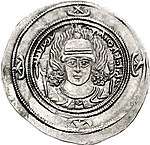Anahid fire-temple
The Anahid fire-temple (Middle Persian: Ādur-Anāhīd) was an ancient fire temple in Istakhr dedicated to the worship of the Iranian goddess Anahid.
History

The temple was probably founded by the Achaemenid king of kings Artaxerxes II (r. 404 – 358 BC), who had shrines and statues of her constructed throughout his realm.[1] The temple was ransacked by the Macedonians during Alexander the Great's conquests.[2] At the start of the 3rd century AD, the temple was repaired and adorned by the Persian Sasanian family, who acted as the hereditary caretakers of the temple; Sasan, the eponymous ancestor of the family, is the first attested member to serve as the warden of the temple.[3] The guardianship of the temple was of high importance to the Sasanians.[2]
Ardashir I (r. 224–242), who overthrew the Parthian Empire and established the Sasanian control over the country, reportedly sent the heads of his enemies in his early campaigns to the temple, which was later repeated by Shapur II (r. 309–379), who had the heads of Christians stringed there in 340.[2] Under Bahram II, the crown lost much of its religious authority, with the Zoroastrian priest Kartir receiving the guardianship of the Anahid temple.[4][5] Narseh, who overthrew Bahram II's son and successor Bahram III in 293, may have restored the temple to their family.[6] By Shapur II's reign, however, the Sasanian hold over the temple was certainly restored.[7]
The last Sasanian emperor of Iran, Yazdegerd III, was crowned in the Anahid temple in 632.[8][2]
References
- Boyce, Chaumont & Bier 1989, pp. 1003–1011.
- Boyce 1998, pp. 643–646.
- Streck & Miles 2012; Canepa 2018; Boyce 1998, pp. 643–646; Boyce, Chaumont & Bier 1989, pp. 1003–1011
- Shahbazi 1988, pp. 514-522.
- Daryaee 2014, p. 11.
- Daryaee 2014, p. 13.
- Sauer 2017, p. 91.
- Frye 1983, p. 171.
Sources
- Bivar, A. D. H. (1998). "Eṣṭaḵr i. History and Archaeology". Encyclopaedia Iranica, Vol. VIII, Fasc. 6. pp. 643–646.CS1 maint: ref=harv (link)
- Boyce, M.; Chaumont, M. L.; Bier, C. (1989). "Anāhīd". Encyclopaedia Iranica, Vol. I, Fasc. 9. pp. 1003–1011.CS1 maint: ref=harv (link)
- Boyce, Mary (1998). "Eṣṭaḵr ii. As a Zoroastrian Religious Center". Encyclopaedia Iranica, Vol. VIII, Fasc. 6. pp. 643–646.CS1 maint: ref=harv (link)
- Canepa, Matthew (2018). "Staxr (Istakhr) and Marv Dasht Plain". In Nicholson, Oliver (ed.). The Oxford Dictionary of Late Antiquity. Oxford: Oxford University Press. ISBN 978-0-19-866277-8.CS1 maint: ref=harv (link)
- Daryaee, Touraj (2012). "The Sasanian Empire (224–651)". In Daryaee, Touraj (ed.). The Oxford Handbook of Iranian History. Oxford University Press. ISBN 978-0199732159.CS1 maint: ref=harv (link)
- Frye, R. N. (1983), "Chapter 4", The political history of Iran under the Sasanians, The Cambridge History of Iran, 3, Cambridge University Press, ISBN 978-0-521-20092-9CS1 maint: ref=harv (link)
- Kia, Mehrdad (2016). The Persian Empire: A Historical Encyclopedia [2 volumes]. ABC-CLIO. ISBN 978-1610693912.CS1 maint: ref=harv (link)
- Sauer, Eberhard (2017). Sasanian Persia: Between Rome and the Steppes of Eurasia. London and New York: Edinburgh University Press. pp. 1–336. ISBN 9781474401029.CS1 maint: ref=harv (link)
- Shahbazi, A. Shapur (2009). "Persepolis". Encyclopaedia Iranica.CS1 maint: ref=harv (link)
- Shahbazi, A. Shapur (1988). "Bahrām II". Encyclopaedia Iranica, Vol. III, Fasc. 5. pp. 514–522.CS1 maint: ref=harv (link)
- Streck, M.; Miles, G.C. (2012). "Iṣṭak̲h̲r". In P. Bearman; Th. Bianquis; C.E. Bosworth; E. van Donzel; W.P. Heinrichs (eds.). The Encyclopedia of Islam, Second Edition. Brill Online. doi:10.1163/1573-3912_islam_SIM_3672.CS1 maint: ref=harv (link)
- Wiesehöfer, Joseph (1986). "Ardašīr I i. History". Encyclopaedia Iranica, Vol. II, Fasc. 4. pp. 371–376.CS1 maint: ref=harv (link)